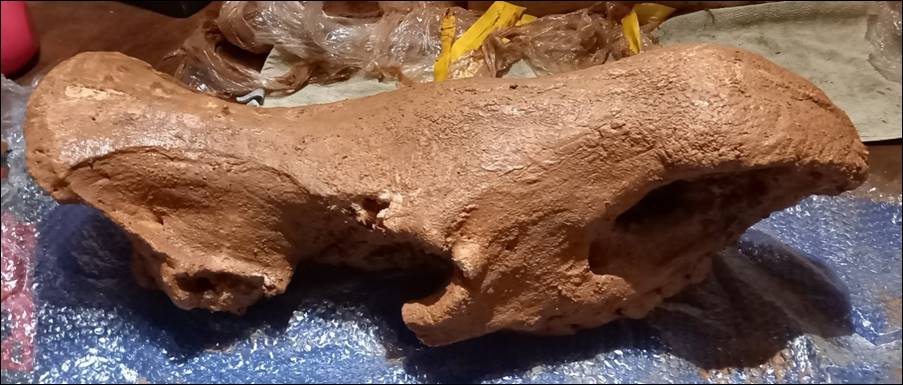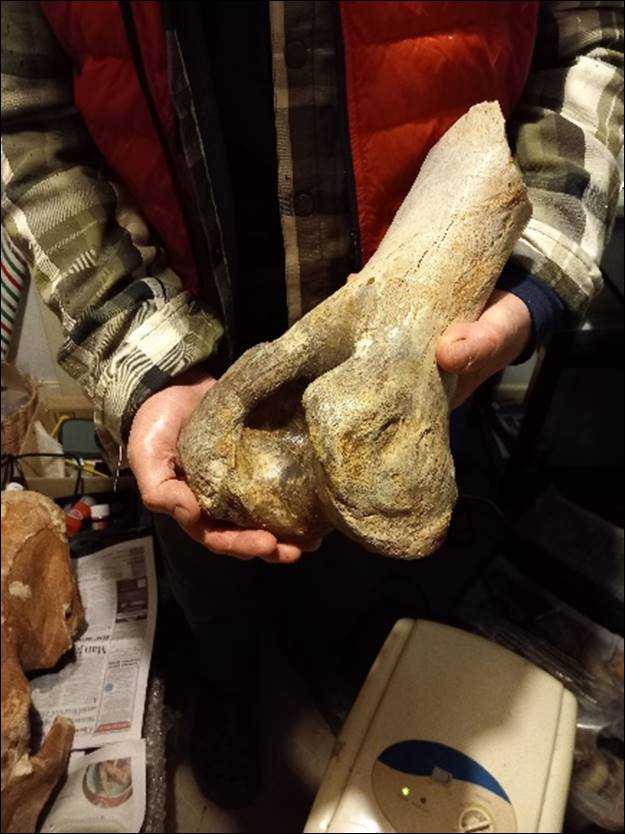[A similar version of this report was published in Cave & Karst Science, Vol. 52 (1), 2025, p.32-34. Transactions of the British Cave Research Association.]
Quarter Way Up Hole (QWUH) is a small cave in Fairy Cave Quarry, Mendip Hills, Somerset (NGR ST 65529 47500). It is being dug actively by cavers in an effort to extend its current open length. It was during this process, early in 2025, that they uncovered some interesting and significant faunal remains, the digging team immediately sought advice and assistance. On 9th February 2025, the excavation leading to the recovery of a woolly rhinoceros (Coelodonta antiquitatis) skull took place at the cave. The skull had been located within an unstable boulder ‘choke’ and, because it was lying in an especially vulnerable position, it was clearly evident that immediate recovery was the only safe option. Several other partial skeletal elements, including femora and humeri, had previously been recovered, and these together with the skull form a substantial assemblage.

Subsequently, the skull and other remains were cleaned carefully, to remove fine-grained sediments and granular material, after which they were allowed to dry slowly under controlled conditions. The skull and associated assemblage of faunal remains (including other species) have been deposited in the care of Professor Danielle Schreve at the University of Bristol. After an initial examination, Danielle has provided the following observations:
“The skull is absolutely magnificent, and I can confirm it is that of a large, male woolly rhinoceros. It’s also an old animal. Not only are its teeth very worn but it has a completely ossified nasal septum (the bony plate separating the two nostrils), which is a feature that gradually develops as the animal gets older, in order to strengthen the skull and support the very large nasal horn. Other features of the skull and shape of the nose also support this being an old individual and based upon comparison with the longevity of the extant white rhino, which has a similar morphology and grazing diet to the woolly rhinoceros, my provisional estimate is that the QWUH specimen was around 40 years old at time of death…
I haven’t looked in detail at the bones of the skeleton yet and there is work to be done refitting the fragments but there are parts of the major limb bones (humerus and femur) present. I am sure this must have been a whole animal that fell into the cave. It is very rare to find a complete individual in the fossil record and I only know of two other complete or partially complete woolly rhino skeletons in Britain, both of which were also accidental deaths…
The skull is beautifully preserved and covered with thin flowstone encrustation. It might be possible to get a Uranium series date on the stal, but the best initial option would be a radiocarbon date on the bone. For the time being, in terms of the geological age of the specimen, it is probably 40-50 000 years old and dates to the middle part of the last Ice Age…They are extinct in Britain by about 35 000 years ago.”
Currently, the recovered faunal assemblage from QWUH is undergoing more detailed study and conservation work, as mentioned above several of the fragmented bones refit.
Other sites on the Mendip Hills where woolly rhinoceros have been found include Gully Cave (Ebbor), Hyaena Den (Wookey Hole), Picken’s Hole (Compton Bishop), and Sandford Hill. Woolly rhinoceros, Coelodonta antiquitatis, has been recorded from the Lower Cave Earth deposits at Pin Hole, Creswell Crags, Derbyshire and has therefore been listed as part of the Pin Hole Mammal Assemblage Zone (MAZ), attributed to the Middle Devensian, MIS 3, c.59-24 ka. The Pin Hole MAZ also includes other large herbivores such as woolly mammoth, Mammathus primigenius, steppe bison, Bison priscus, wild horse, Equus ferus, and reindeer, Rangifer tarandus (Currant & Jacobi, 2001). During the Middle Devensian conditions were generally cold and dry, although the period is characterized by sharply oscillating climates ranging between milder periods and short cooling episodes, in which dry grassland ‘mammoth-steppe’ environments were dominant (Webster, 2008).



Sources consulted
Andrew Currant & Roger Jacobi. 2001. A formal mammalian biostratigraphy for the Late Pleistocene of Britain. Quaternary Science Reviews 20 (2001) p. 1707-1716
Chris Webster. 2008. The Archaeology of South West England, South West Archaeological Research Framework (SWARF). Somerset County Council
Professor Danielle Schreve personal communications
https://www.mcra.org.uk/registry Mendip Cave Registry & Archive Online search, accessed 18th March 2025

